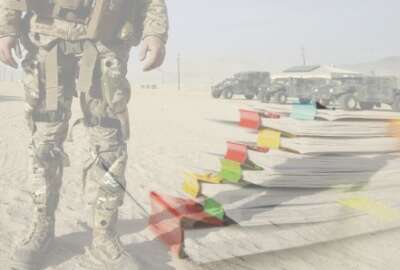Hubbard Radio Washington DC, LLC. All rights reserved. This website is not intended for users located within the European Economic Area.
This retired one-star takes his armaments experience to the private sector
To fight and win the nation's wars, the Defense Department needs the best possible armaments. The National Armaments Consortium brings together contractors, res...
Best listening experience is on Chrome, Firefox or Safari. Subscribe to Federal Drive’s daily audio interviews on Apple Podcasts or PodcastOne.
To fight and win the nation’s wars, the Defense Department needs the best possible armaments. The National Armaments Consortium brings together contractors, researchers and academics in the development of new armament technologies for the military to acquire and test. Now the consortium has a new vice president of customer engagement, retired Army Brigadier General Al Abramson. The Federal Drive with Tom Temin spoke with him.
Interview transcript:
Tom Temin: Good to have you on.
Al Abramson: Thanks for having me, Tom.
Tom Temin: And you bring a long background in the Army and in the armaments area particularly, what are some of the big challenges in armaments? Because it seems like kind of a basic thing. You’ve got cannons and rifles and pistols and bombs that are well understood technologies.
Al Abramson: That’s a great question and the background I bring. So I’ve served in the military for just over 30 years, and quite recently, and quite recently is a relative term, but about four years ago, the Army made a decision to really focus in on modernizing the Army as it is today. And so if we go back a little bit, we’ve been fighting counterinsurgent war for 20 years in Iraq and Afghanistan, and so those have kind of trickled away. But now we have other threats that we need to focus on. And the question is, are our troops, are our war fighters, have the proper capabilities to fight that particular war, peace through strength, but fight that particular war, if and when necessary in the defense of our nation, and that’s really what the focus is all about.
Tom Temin: And armaments, the term refers to give us a sense of what types of equipment and what types of technologies that actually covers.
Al Abramson: You hit the nail on the head again at the beginning. So armaments really comprises weapon systems. So handgun is an armament, a rifle is an armament, a tank, the Abrams tank not named after me is an armament, so field artillery pieces are armaments. But also the munitions that go along with it, field artillery, munitions, small caliber, medium caliber, large caliber, those all things that make up the weapon system itself, we call armaments.
Tom Temin: And so that includes the ordinance the actual projectile?
Al Abramson: Absolutely, absolutely.
Tom Temin: And if you get down to the most basic level, the thing that actually causes the chemical reaction you want, either to fire a projectile or to explode, that is actually something that is not a static industry, either, is it?
Al Abramson: It’s not a static industry. And so I called it a very delicate ecosystem of these chemicals that our nation brings together to either provide the explosives that we want, or the propellant that we need. And so those two things propellant and explosives are really the building blocks to creating a more capable, more lethal weapon system. It goes and then it does something that you want it to do.
Tom Temin: And if you were to increase, say, through some good chemical research and some good testing the explosive power of a particular propellant, for example, that could I imagine back upstream to how you handle the system that is using the propellant because you don’t want it to blow up from too much propellant.
Al Abramson: Yeah. So a great analogy, if you have a basketball, put into a basketball. And so today’s basketball, 50% propellant and 50% explosive, well, let’s just say we want to take that basketball and throw it a little bit further. And we have to increase the amount of propellant. And so now we have a little bit less space for explosives. So we’ve got to do something with the explosive component to make it a little bit more lethal, if you will, because what you don’t want to do is if you throw that basketball a certain distance, you don’t want it to be like a paintball, you still want to have the intended effect on target at a greater distance. So that requires some chemical equations that we need to work on.
Tom Temin: And from your experience, how much of this research is conducted by say, in the case of the Army, Army personnel, versus how much is contracted out to the research organizations or to industry.
Al Abramson: So at Picatinny, I called it the Center of Excellence for Lethality. Because Picatinny although I wore my Army uniform, it really focused on the lethality effects across the services. So there’s a great bunch of folks, about 6,500 contractors, civilians and military uniforms that work at Picatinny, but also with the NAC, there are about 950-ish industry partners that also are all focused on getting after building these greater capabilities.
Tom Temin: We’re speaking with retired Army Brig. Gen. Al Abramson. He’s now vice president of customer engagement for the National Armaments Consortium. And tell us about your new job now as the vice president of customer engagement.
Al Abramson: Well, yeah, thanks for that. So, in my previous role as the commanding general of Picatinny, I came across and spoke at the National Armaments Consortium general membership meeting, and my eyes were open to how this consortium brought all of those smart folks together, the large business, small business, academia, nontraditionals coming together to collaborate together in an environment that they may not have been able to come across and speak to each other, all with a singular focus of being able to build better capabilities for our warfighters. And so being part of that effort was a great opportunity for me, and I look forward to continuing to work with them.
Tom Temin: And if you think about some of the national challenges, of which there are big priorities for the federal government, cybersecurity, quantum computing is even one, satellite technology, armaments would seem kind of basic or low tech compared to those. But in reality, I imagine you can tell me, from your point of view, does it look like some of the adversary nations are also doing research, say China, which invented fireworks. We know they’re ahead and quantum, and they’re very big and satellites and cyber. Are they also pursuing armaments and greater power there, also?
Al Abramson: I would say the answer to that question is yes. And so, although armaments, in terms of the complexity of those different enterprises that you spoke about, each one is challenging in and of itself, and I would put that the armaments, our ability to provide greater capability for the future is just as challenging, but it has different challenges, if you will. So it’s just as challenging.
Tom Temin: What are the big challenges in terms of the next round, say, of armaments? Is it a chemical issue? Is it a physics issue, or what is it?
Al Abramson: I would say all of the above. One, I’ll go back to the ecosystem of the supply chain of bringing ammunition together as a very quick example. And so one of those piece parts that go into a munition, our ability to evolve it, modernize it, to ensure that it provides a greater capability for that particular weapon system is very delicate, meaning if we don’t have it, if we don’t have that supply chain coming in, then it’s just not going to work. On another piece, to your point about being able to create greater explosive capability at longer ranges, we’ve got to be able to work on that chemical equation, that chemical structure so that we can have a smaller amount but have the same explosive component of where we want to go.
I’ll add one more, because you talked about satellites. Our munitions today are no longer what I would call dumb. Meaning we fire them from a munition, or weapon system or fill artillery round, and it was a dumb weapon, meaning it didn’t have to look at satellites and know where it is in time and space. Well, I will tell you today that some of our munitions today, once you fire them, it’s got to acquire the satellite, it’s got to acquire the satellite so it knows where it is in time and space, and can have an accurate targeting capability where we didn’t have that 10 years ago.
Tom Temin: And maybe it’s my imagination, but I thought I recall seeing somewhere, a video or something on the idea that actually an individual bullet can change course and go around a corner, or am I making that up?
Al Abramson: It depends on the size of the bullet, I’ll leave it at that. So small arm, we’re not quite there yet, but larger ones can change their trajectory without going too far into classifications and things.
Tom Temin: OK, all right. That is something that’s real, though the idea of —
Al Abramson: That is real.
Tom Temin: — Guiding something smaller and smaller —
Al Abramson: That is a correct.
Tom Temin: — As opposed to, you know, intercontinental missile, which has a trajectory and so forth. And by the way, does armaments go up to that level to the guided missile level of weapon?
Al Abramson: So the answer to that question is yes, armaments does. So PEO missiles in space deals with rockets and things like that, that are particularly guided. Now, your example that you use, we would call a conventional, can a conventional munition change its trajectory? And the answer to that question is, we’re developing that capability as we speak. But the rocket, as you’ve mentioned, has always been able to do that.
Tom Temin: All right, so as the customer engagement person, point man for their for the consortium, you’ll be visiting, it sounds like, and dealing with the vendor base with the supply base issues, from again, I guess, looking back to the Army standpoint, but now you can see it from the vendor side. Are the supply chain issues that affect so much of industry, also affecting the armaments industry?
Al Abramson: It does. And again, I go back to a very, I called it a very delicate ecosystem, because it would come in from many different pipelines. And I can only imagine due to our real life situation with the COVID virus and supply chain things. It’s becoming more and more increasingly challenging to ensure that our industry partners, both large small mom and pop shops, if you will, are being able to get the things that they need so they can continue to feed that pipeline of many different directions to build that weapon system and that lethal capability that our warfighters need.
Tom Temin: Well, it seems like things are improving. You can get nine millimeter rounds now for less than 50 cents apiece. So I guess that’s a good trend. They were a buck. You know, a year and a half ago. Retired Army Brig. Gen. Al Abramson is vice president of customer engagement for the National Armaments Consortium. Thanks so much for joining me.
Al Abramson: Thanks for having me.
Copyright © 2024 Federal News Network. All rights reserved. This website is not intended for users located within the European Economic Area.
Tom Temin
Tom Temin is host of the Federal Drive and has been providing insight on federal technology and management issues for more than 30 years.
Follow @tteminWFED





